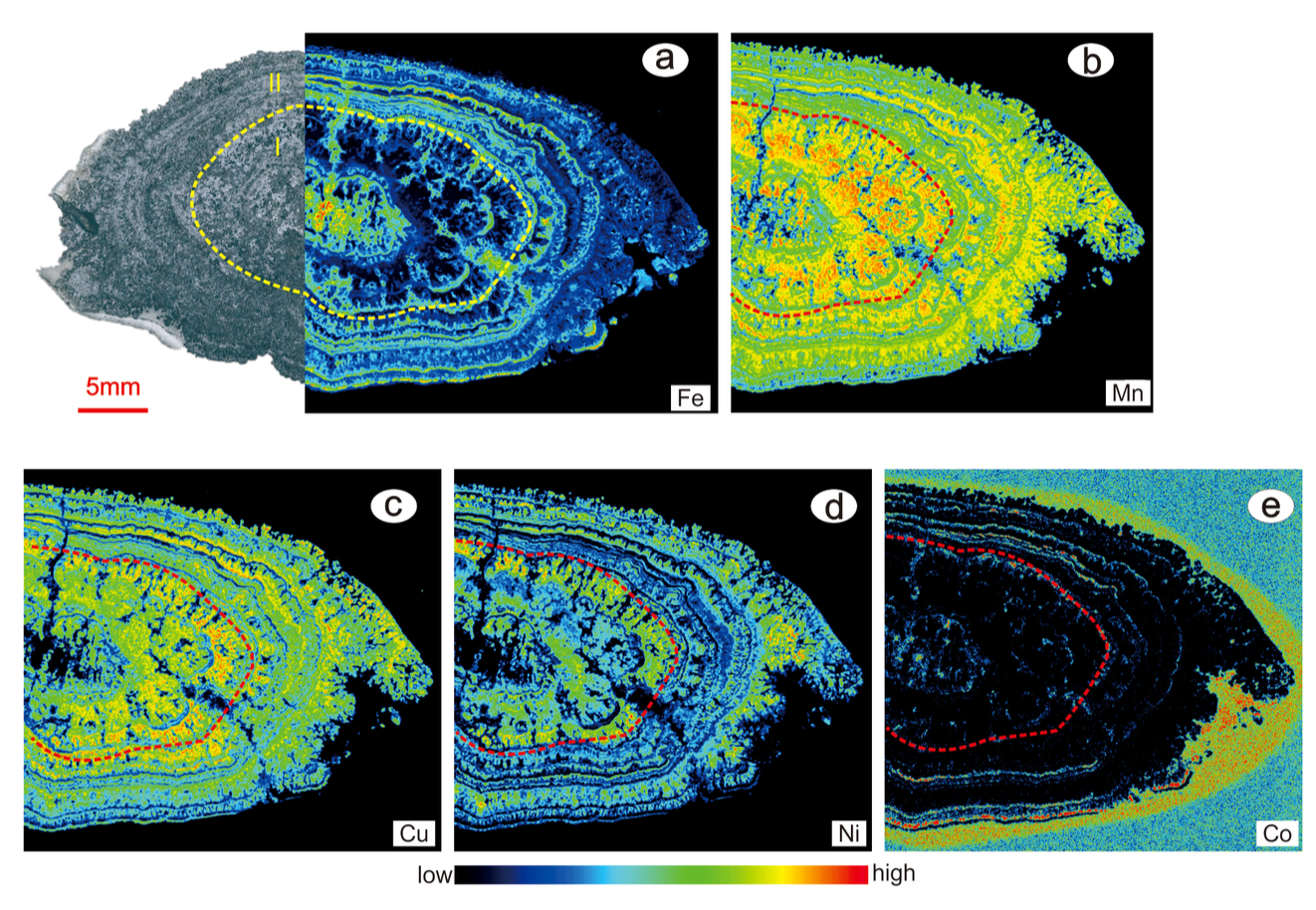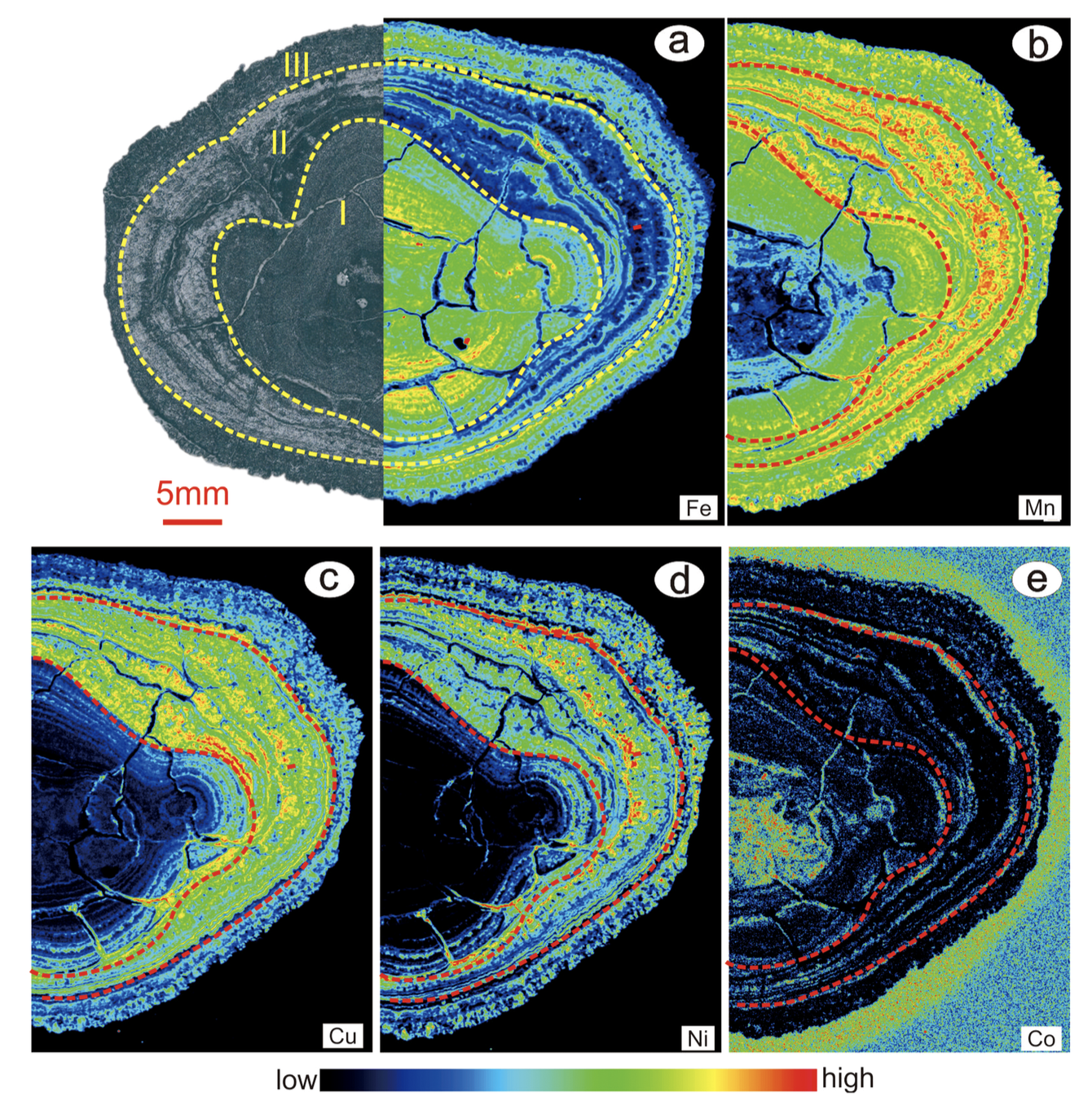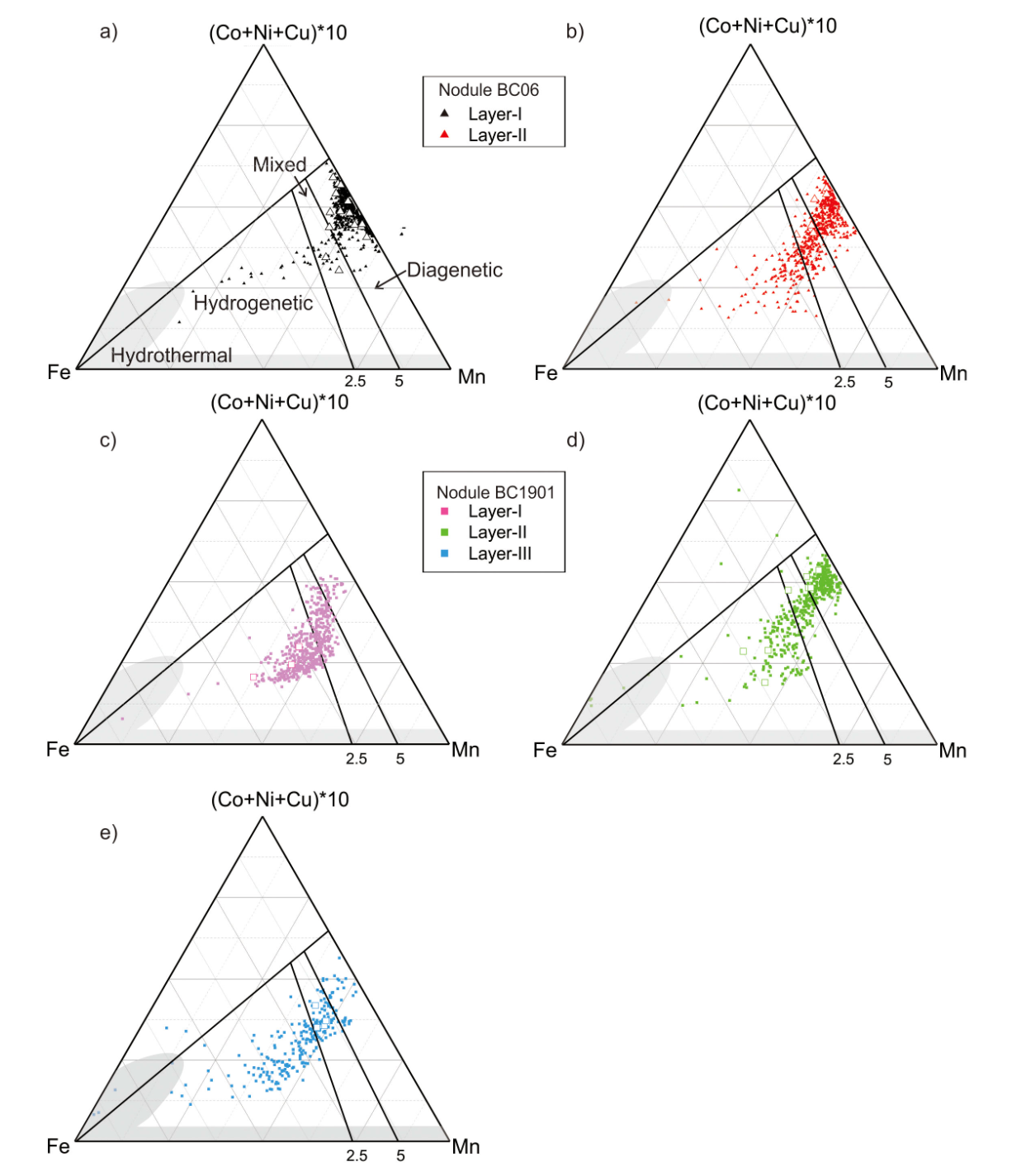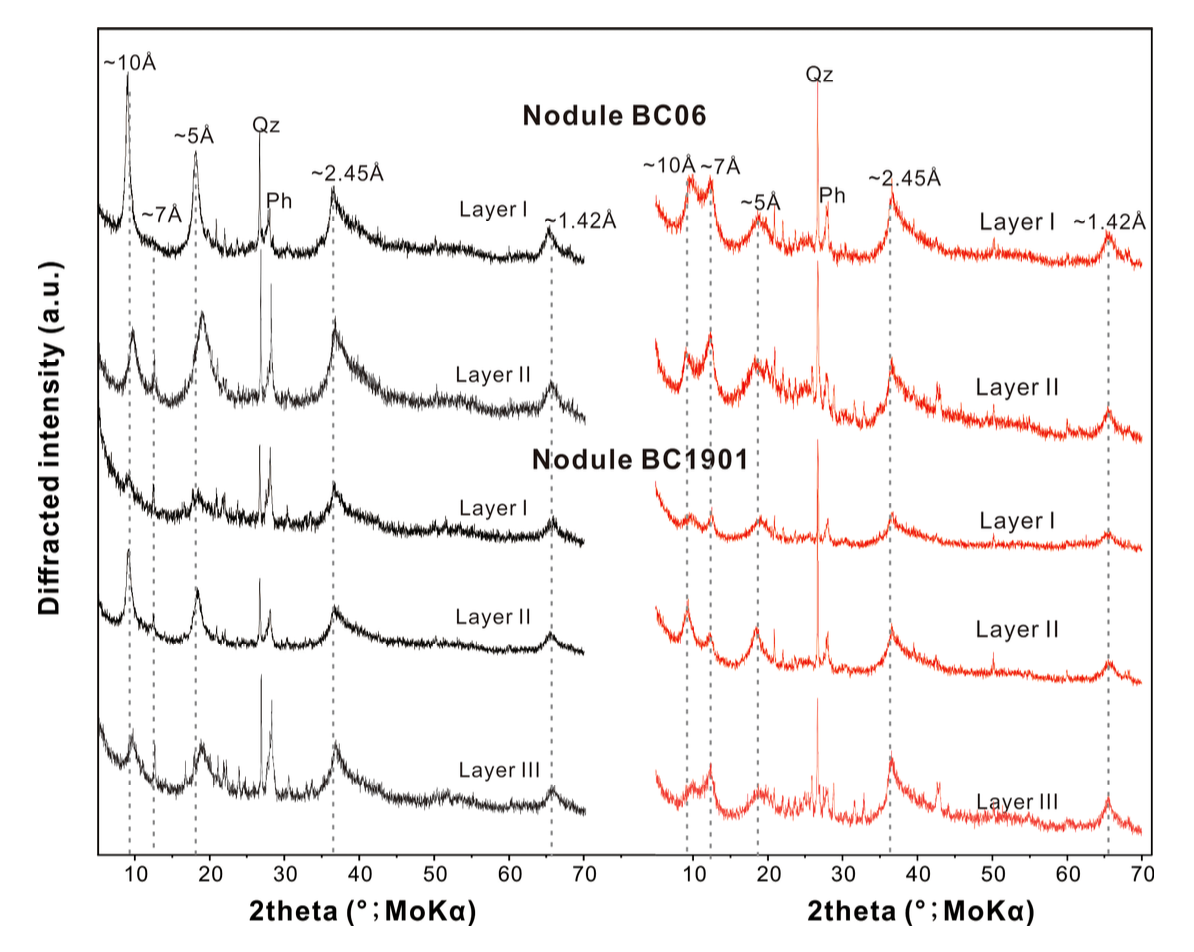What Controls the Chemistry of Seafloor Metal Nodules

Title: In-situ analysis of polymetallic nodules from the Clarion-Clipperton Zone, Pacific Ocean: implication for controlling on chemical composition variability
Authors: Jie Li, Yinjia Jin, Hao Wang, Kehong Yang, Zhimin Zhu, Xingwei Meng, and Xiaohu Li
Journal & Year: Frontiers in Marine Science, 2024
BLUF: Layer-scale chemistry in CCZ nodules records alternating diagenetic and hydrogenetic growth. An eastern nodule shows a highly diagenetic core with extreme Mn/Fe and elevated Ni+Cu that relaxes outward, while a western nodule starts hydrogenetic, shifts to a diagenetic middle rich in Mn, Ni, and Cu, then trends back toward hydrogenetic conditions. Validated in-situ methods reveal why nodule grades vary across tracks and offer practical means to forecast metal distribution for exploration and planning.
Two nodules were sampled at about 5,000 meters depth: BC06 in the eastern CCZ at 12.34° N, 122.16° W, and BC1901 in the western CCZ at 9.38° N, 156.50° W. Microtextures were examined by reflected-light and backscattered electron imaging. Major and trace elements were acquired both as LA-ICP-MS spot data and as line scans across micro-layers, calibrated to NIST SRM 610/612 and USGS NOD-A-1 with external reproducibility better than roughly ±10 percent for most majors and REY. Element maps were produced with micro-XRF, and XRD before and after heating to 105 °C separated 7 Å and 10 Å phases, distinguishing unstable buserite I from stable buserite II and todorokite.
BC06 contains two layers, with a detrital, porous core and a porous dendritic rim. BC1901 contains three layers, transitioning from massive inner textures to laminated middle layers and a dendritic outer shell. As the study’s micro-XRF element maps figure shows, Mn, Ni, and Cu dominate most of BC06, with only thin Fe-rich laminae in the outer layer.

In contrast, the same figure for BC1901 shows Fe concentrated in the inner and outer parts, while Mn, Ni, and Cu peak in the middle layer; cobalt tracks thin Fe-rich microlayers and the nucleus.

Across both nodules, Mn can reach about 35.97 wt percent, Cu about 2.52 wt percent, and Ni about 2.87 wt percent in Mn-rich layers, whereas Fe and Co in those same layers can fall to about 0.74 wt percent and 0.01 wt percent, respectively. The highest Mn/Fe observed is about 44.79. In BC06, the inner Layer I shows the strongest diagenetic signature with Mn/Fe up to 44.78 and Ni+Cu up to 5.30 wt percent, while the outer Layer II shifts toward a mixed hydrogenetic–diagenetic field. In BC1901, Layer I is hydrogenetic with Fe-rich vernadite and low Mn/Fe, with a maximum of 1.82; Layer II becomes more diagenetic, and Layer III trends back toward more hydrogenetic conditions. The Fe–Mn–(Ni+Cu)×10 ternary-diagram figure in the paper shows BC06 plotting closer to the diagenetic or mixed fields and locates BC1901 Layer I squarely in the hydrogenetic field, with Layers II and III spanning mixed space.

XRD confirms the phase story. The diffractogram figure demonstrates that the 10 Å peak is sharpest in BC06 Layer I and in BC1901 Layer II, marking intervals with the most ordered 10 Å phyllomanganates and stronger diagenetic input. Heating to 105 °C collapses much of the 10 Å signal to 7 Å, identifying a large fraction of buserite I, while residual 10 Å signals indicate stable buserite II or todorokite. Layer I of BC1901 lacks a strong 10 Å peak and is Fe-rich, consistent with hydrogenetic vernadite.

Summed REY span about 211 to 1,448 mg per kg across layers. Both nodules show LREE enrichment over HREE and weak positive Eu anomalies. BC06 has lower YN/HoN and smaller to negative Ce anomalies than BC1901, with BC06 dCe ranging from 0.38 to 1.70 and YN/HoN from 0.41 to 0.74, compared with BC1901 dCe from 1.07 to 1.92 and YN/HoN from 0.59 to 0.84. These differences are consistent with stronger pore-water influence in BC06 and more oxic seawater inputs at the start and end of BC1901 growth.
Element ratios plotted as violins show higher Mn/Fe and lower Co/(Cu+Ni) in BC06 overall, whereas BC1901 shows the opposite pattern and a layer-by-layer evolution that mirrors its textural changes. Barium decreases outward in both nodules, tying higher inner Ba to higher export productivity during early growth. In the east, long-term plate motion that shifted the site away from the equatorial high-productivity band likely deepened the oxic–suboxic front through time, weakening diagenetic supply toward the rim. In the west, fluctuations in Antarctic Bottom Water strength alternately favored hydrogenetic precipitation and diagenetic enrichment, aligning with BC1901’s inner hydrogenetic, middle diagenetic, and outer more hydrogenetic sequence.
By tying specific textures and mineral phases to metal-rich diagenetic layers versus more Co-prone hydrogenetic layers, the study provides a roadmap for rapid screening of nodule chemistry at the micro-scale. The demonstrated agreement between LA-ICP-MS line scans and spots supports efficient layer-resolved mapping, and the micro-XRF maps directly visualize where the pay metals cluster within individual nodules. Integrating these figure-based diagnostics into exploration workflows can sharpen targeting, improve grade interpolation between cores and tracks, and reduce uncertainty in block models that underpin planning across lease blocks.



